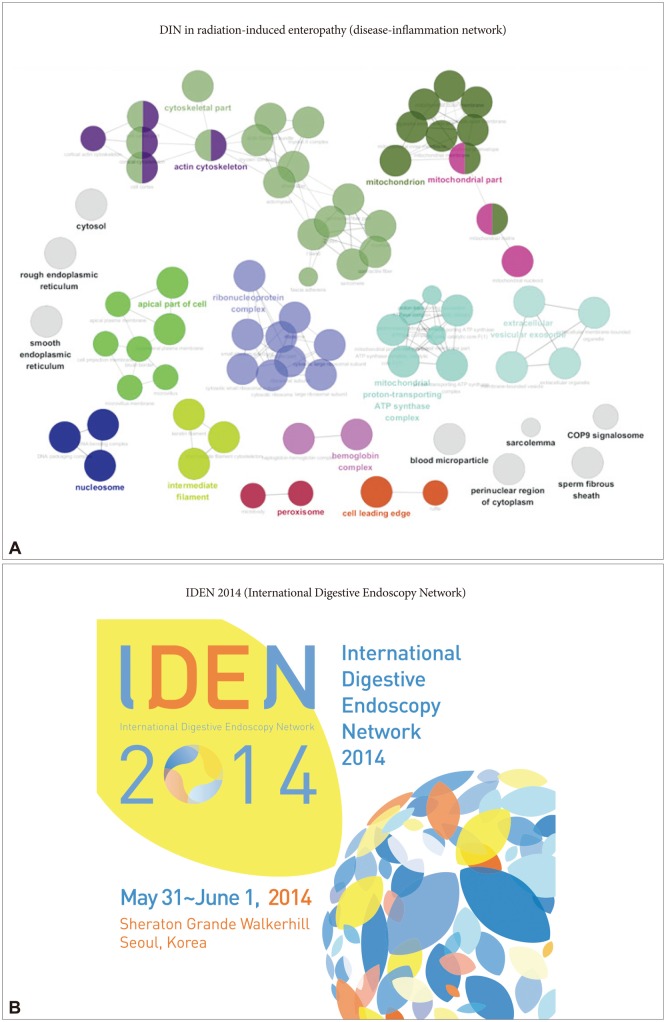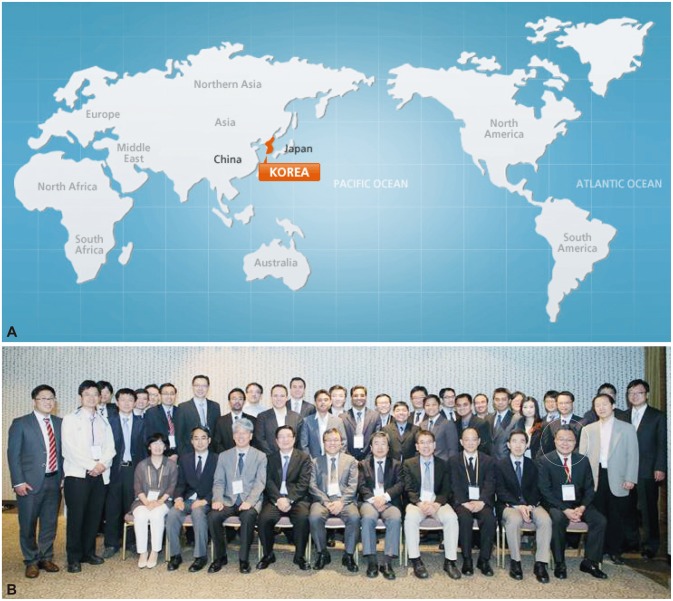Clin Endosc.
2014 Sep;47(5):371-382. 10.5946/ce.2014.47.5.371.
International Digestive Endoscopy Network 2014: Turnpike to the Future
- Affiliations
-
- 1Department of Internal Medicine, Catholic University of Daegu School of Medicine, Daegu, Korea.
- 2Department of Gastroenterology, Gachon University Gil Medical Center, Gachon University of Medicine and Science, Incheon, Korea.
- 3Center for Gastric Cancer, National Cancer Center, Goyang, Korea.
- 4Department of Internal Medicine and Liver Research Institute, Seoul National University College of Medicine, Seoul, Korea.
- 5Department of Gastroenterology, CHA Bundang Medical Center, CHA University, Seongnam, Korea. hahmkb@cha.ac.kr
- KMID: 2165366
- DOI: http://doi.org/10.5946/ce.2014.47.5.371
Abstract
- Social networks are useful in the study of relationships between individuals or entire populations, and the ties through which any given social unit connects. Those represent the convergence of the various social contacts of that unit. Consequently, the term "social networking service" (SNS) became extremely familiar. Similar to familiar SNSs, International Digestive Endoscopy Network (IDEN) 2014 was based on an international network composed of an impressive 2-day scientific program dealing with a variety of topics for gastrointestinal (GI) diseases, which connects physicians and researchers from all over the world. The scientific programs included live endoscopic demonstrations and provided cutting-edge information and practice tips as well as the latest advances concerning upper GI, lower GI, and pancreatobiliary endoscopy. IDEN 2014 featured American Society for Gastrointestinal Endoscopy-Korean Society of Gastrointestinal Endoscopy (ASGE-KSGE)-joint sessions prepared through cooperation between ASGE and KSGE. Furthermore, IDEN 2014 provided a special program for young scientists called the 'Asian Young Endoscopist Award Forum' to foster networks, with many young endoscopists from Asian countries taking an active interest and participation.
Keyword
MeSH Terms
Figure
Reference
-
1. Barabási AL, Gulbahce N, Loscalzo J. Network medicine: a network-based approach to human disease. Nat Rev Genet. 2011; 12:56–68. PMID: 21164525.
Article2. Goh KI, Cusick ME, Valle D, Childs B, Vidal M, Barabási AL. The human disease network. Proc Natl Acad Sci U S A. 2007; 104:8685–8690. PMID: 17502601.
Article3. Boeckxstaens GE, Zaninotto G, Richter JE. Achalasia. Lancet. 2014; 383:83–93. PMID: 23871090.
Article4. Boeckxstaens GE, Annese V, des Varannes SB, et al. Pneumatic dilation versus laparoscopic Heller's myotomy for idiopathic achalasia. N Engl J Med. 2011; 364:1807–1816. PMID: 21561346.
Article5. Pasricha PJ, Hawari R, Ahmed I, et al. Submucosal endoscopic esophageal myotomy: a novel experimental approach for the treatment of achalasia. Endoscopy. 2007; 39:761–764. PMID: 17703382.
Article6. Inoue H, Minami H, Kobayashi Y, et al. Peroral endoscopic myotomy (POEM) for esophageal achalasia. Endoscopy. 2010; 42:265–271. PMID: 20354937.
Article7. Bang BW, Choi YC, Kim HG, et al. Peroral endoscopic myotomy for treating achalasia in an animal model: a feasibility study. Clin Endosc. 2013; 46:54–58. PMID: 23423311.
Article8. Lee BH, Shim KY, Hong SJ, et al. Peroral endoscopic myotomy for treatment of achalasia: initial results of a Korean study. Clin Endosc. 2013; 46:161–167. PMID: 23614126.
Article9. Von Renteln D, Fuchs KH, Fockens P, et al. Peroral endoscopic myotomy for the treatment of achalasia: an international prospective multicenter study. Gastroenterology. 2013; 145:309–311. PMID: 23665071.
Article10. Bhayani NH, Kurian AA, Dunst CM, Sharata AM, Rieder E, Swanstrom LL. A comparative study on comprehensive, objective outcomes of laparoscopic Heller myotomy with per-oral endoscopic myotomy (POEM) for achalasia. Ann Surg. 2014; 259:1098–1103. PMID: 24169175.
Article11. Saito I, Tsuji Y, Sakaguchi Y, et al. Complications related to gastric endoscopic submucosal dissection and their managements. Clin Endosc. 2014; 47:398–403.
Article12. Bok GH, Cho JY. ESD hands-on course using ex vivo and in vivo models in South Korea. Clin Endosc. 2012; 45:358–361. PMID: 23251882.13. Toyonaga T, Nishino E, Man IM, East JE, Azuma T. Principles of quality controlled endoscopic submucosal dissection with appropriate dissection level and high quality resected specimen. Clin Endosc. 2012; 45:362–374. PMID: 23251883.
Article14. Uedo N, Jung HY, Fujishiro M, et al. Current situation of endoscopic submucosal dissection for superficial neoplasms in the upper digestive tract in East Asian countries: a questionnaire survey. Dig Endosc. 2012; 24(Suppl 1):124–128. PMID: 22533767.
Article15. Kim EY, Jeon SW, Kim GH. Chicken soup for teaching and learning ESD. World J Gastroenterol. 2011; 17:2618–2622. PMID: 21677829.
Article16. Oda I, Odagaki T, Suzuki H, Nonaka S, Yoshinaga S. Learning curve for endoscopic submucosal dissection of early gastric cancer based on trainee experience. Dig Endosc. 2012; 24(Suppl 1):129–132. PMID: 22533768.
Article17. Singh S, Singh PP, Murad MH, Singh H, Samadder NJ. Prevalence, risk factors, and outcomes of interval colorectal cancers: a systematic review and meta-analysis. Am J Gastroenterol. 2014; 109:1375–1389. PMID: 24957158.
Article18. Tanaka S, Terasaki M, Kanao H, Oka S, Chayama K. Current status and future perspectives of endoscopic submucosal dissection for colorectal tumors. Dig Endosc. 2012; 24(Suppl 1):73–79. PMID: 22533757.
Article19. Repici A, Hassan C, De Paula Pessoa D, et al. Efficacy and safety of endoscopic submucosal dissection for colorectal neoplasia: a systematic review. Endoscopy. 2012; 44:137–150. PMID: 22271024.
Article20. Fujishiro M. Endoscopic submucosal dissection for colorectal neoplasms. World J Gastrointest Endosc. 2009; 1:32–38. PMID: 21160648.
Article21. Oyama T. Counter traction makes endoscopic submucosal dissection easier. Clin Endosc. 2012; 45:375–378. PMID: 23251884.
Article22. Raju GS, Saito Y, Matsuda T, Kaltenbach T, Soetikno R. Endoscopic management of colonoscopic perforations (with videos). Gastrointest Endosc. 2011; 74:1380–1388. PMID: 22136781.
Article23. Kim EY. Fine-needle biopsy: should this be the first choice in endoscopic ultrasound-guided tissue acquisition? Clin Endosc. 2014; 47:425–428.
Article24. Bang JY, Varadarajulu S. Neoplasia in chronic pancreatitis: how to maximize the yield of endoscopic ultrasound-guided fine needle aspiration. Clin Endosc. 2014; 47:420–424.
Article25. Lee TH, Moon JH, Park SH. Bilateral metallic stenting in malignant hilar obstruction. Clin Endosc. 2014; 47:440–446.
Article26. Widmer JL, Kahaleh M. Endoscopic ultrasound-guided treatment beyond drainage: hemostasis, anastomosis, and others. Clin Endosc. 2014; 47:432–439.
Article27. Ko KH, Kwon CI, Park JM, Lee HG, Han NY, Hahm KB. Molecular imaging for theranostics in gastroenterology: one stone to kill two birds. Clin Endosc. 2014; 47:383–388.
Article28. Kang YK. Diminutive and small colorectal polyps: the pathologist's perspective. Clin Endosc. 2014; 47:404–408.
Article29. Lee TH, Lee CK. Endoscopic sedation: from training to performance. Clin Endosc. 2014; 47:141–150. PMID: 24765596.
Article30. Bang JY, Varadarajulu S. Endoscopic ultrasound-guided management of pancreatic pseudocysts and walled-off necrosis. Clin Endosc. 2014; 47:429–431.
Article
- Full Text Links
- Actions
-
Cited
- CITED
-
- Close
- Share
- Similar articles
-
- Upper Endoscopy in International Digestive Endoscopy Network 2012: Towards Upper End of Quality
- Sketch of International Digestive Endoscopy Network 2012 Meeting: Overview
- Highlights of Pancreatobiliary Endoscopy in International Digestive Endoscopy Network 2012: How Much Has It Advanced?
- International Digestive Endoscopy Network to Strengthen Network for Lower Gastrointestinal Diseases Including Inflammatory Bowel Disease and Colorectal Cancer
- Highlights of International Digestive Endoscopy Network 2013



